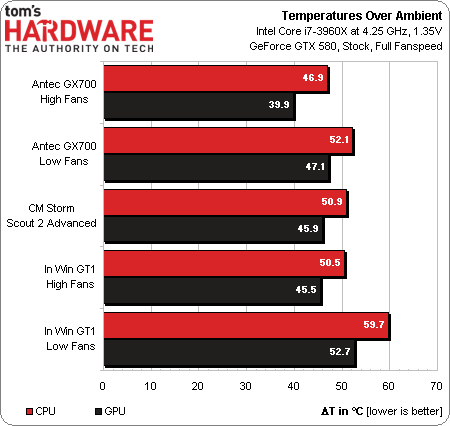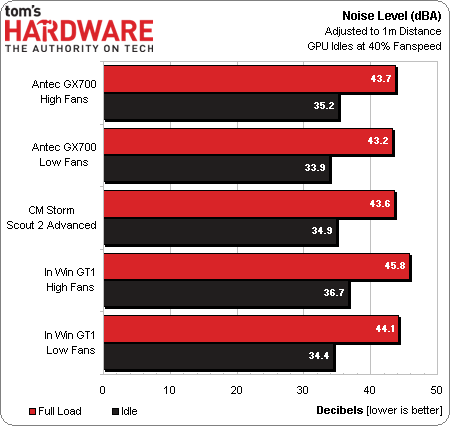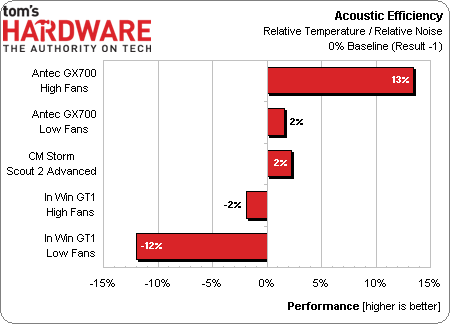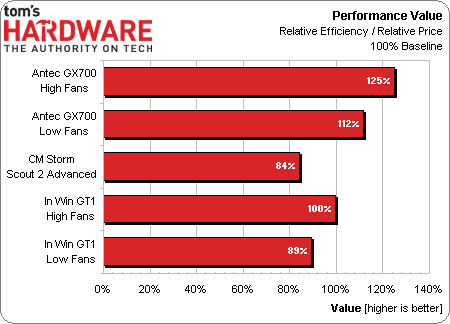The Final Three: Sub-$100 Cases For Your Gaming Build
The journey was a long one, but we're finally wrapping up our round-up of sub-$100 gaming cases. Today we review the last three of 11 total product submissions and pick an overall favorite. The competition was vicious, but one model definitely stands out.
Test Results For Today’s Three Contenders
What’s up with Antec? The GX700 manages some amazingly-low temperatures in spite of its lack of intake fans, relying instead on exhaust fans to do all of the work.
One nice thing about exhaust fans is that they make less apparent noise than intakes, since they’re farther away from the user. Measuring noise from 45° off the front panel, much of the case isolates users from Antec’s exhaust.
The combination of good heat removal, more distance from the forward-placed sound meter, and case material between the sound meter and exhaust fan adds up to a big win in the GX700’s heat-to-noise comparison.
Meanwhile, a low $60 price combines with good overall performance to put the GX700 on top of our value charts.
All those performance and value statistics should make Antec’s GX700 an easy pick for an award, but other issues prevent me from issuing a broad recommendation. Some of the more minor issues, such as a top bay that’s blocked by top-panel connector cables, might be overlooked in consideration of the GX700’s four bays. After all, most of its competitors have only three bays from the outset. A front-panel audio cable that’s too short to fit most motherboards could also be forgiven since you can pull it out of its routing holes and loop it over the top of the motherboard, even if that's a pretty ugly workaround.
Like many of its competitors, the GX700 doesn’t have an eighth slot to enable the installation of a double-slot graphics card in a motherboard’s bottom slot. Yet, with a price of only $60, anyone shopping for the GX700 probably won't give that much thought. They might think about the GX700’s use of break-out slot covers though, which give you the option of either twisting the adjoining metal by using tools to remove them or cutting your hands by using your fingers to pop them out as delicately as possible. And whenever you think about swapping cards in or out, you'll also need to think about where you’ll find more slot covers, since the pop-outs can't be re-installed.
Perhaps that’s why Antec recommended its Eleven Hundred in light of our quality concerns, though even its older Three Hundred has this one beat on those terms.
Get Tom's Hardware's best news and in-depth reviews, straight to your inbox.
Current page: Test Results For Today’s Three Contenders
Prev Page Test Settings Next Page All Eleven Cases, Compared-
envy14tpe Thanks for doing the sub $100 cases. Obviously these are the most important ones.Reply
Is there any way tomshardware can put all the data together on a couple spreadsheets? -
JJ1217 I'd like to see an article for this for cases that are larger, like the HAF X, Switch 810, and a few others. Be interesting to see them compared.Reply -
Crashman Reply11083777 said:Thanks for doing the sub $100 cases. Obviously these are the most important ones.
Is there any way tomshardware can put all the data together on a couple spreadsheets?
Performance data?
http://www.tomshardware.com/reviews/antec-gx700-cooler-master-storm-scout-2-advanced-in-win-gt1,3512-10.html
Or do you mean dimensional data?
-
ojas Hey about the GX700: Only exhaust would mean more dust build up (negative internal air pressure) so how does that factor in?Reply -
envy14tpe Reply
That's exactly what I was looking for.11083962 said:11083777 said:Thanks for doing the sub $100 cases. Obviously these are the most important ones.
Is there any way tomshardware can put all the data together on a couple spreadsheets?
Performance data?
http://www.tomshardware.com/reviews/antec-gx700-cooler-master-storm-scout-2-advanced-in-win-gt1,3512-10.html
Or do you mean dimensional data?
-
vertexx Thanks for doing all the analysis. Cases are so subjective and have so many factors, and it all comes down to trade-offs.Reply
I thought the final analysis was perhaps a bit brief with so many cases reviewed. It would be good to see some type of point or rating system for different factors that go into overall case value (i.e. Finish Quality, Build Quality, Component Accessibility, Flexible Layout Options, Cable Management). -
Onus If one can deal with its anomalies (dealbreakers for some I'm sure), the Antec GX700 looks like a winner. I'm not sure about the styling, but that Ostrog does look like a good choice too. The Storm Scout looks like a bigtime value loser, and I'm very surprised Rosewill didn't do better. I suspect a lot of positions might change if you allow a certain amount of modding and tweaking though. I think this is why selecting a case will remain a matter of personal preference, regardless of what stock benchmarks show.Reply -
Spooderman I built my friend's PC in the In Win and it was a good experience. Cable management was acceptable, everything fit nicely, nice color scheme. There was an interesting moment when I noticed that the case was built to include its own standoffs in the form of raised bumps on the motherboard tray. This scared me because I didn't trust putting the mobo on the case, but I looked it up and apparently the standoffs that came with the case were only for micro ATX. The front panel design and lights were nice looking and mostly unobtrusive. Other than that, it was a great case to build in and I think I'll be using it for my next friend's build this summer. Out of all the cases I would recommend this one for a good building experience.Reply -
JPNpower So which is the good budget case that doesn't look like a flashy monster? I know it shouldn't matter, but I personally couldn't stand many of these cases sitting in my living room.Reply -
Onus I'd take a look at Fractal Designs or Lian Li for a much more subdued styling, and also quiet. I don't mind a blue light here or there (if only to tell me the PC is on, ready to do as I tell it), but I don't like garish either; not in the living room anyway.Reply




